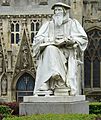Elizabethan Religious Settlement facts for kids
The Elizabethan Religious Settlement was Elizabeth I’s plan to end the big religious arguments in England. These arguments had been going on for a long time, especially during the reigns of her father Henry VIII, her brother Edward VI of England, and her sister Mary I of England.
Elizabeth’s plan was put into action through two important laws passed by the Parliament of England. The Act of Supremacy of 1559 made the English church independent from the Pope in Rome. The Act of Uniformity of 1559 decided how the English church would be run and what its services would look like.
Many people see this settlement as the end of the English Reformation. It also helped create what we now call Anglicanism. However, some historians believe that England only truly became a Protestant country much later. It seems there were still many disagreements among people and church leaders for a long time after Elizabeth’s changes.
Contents
Why England Needed a Religious Plan
England went through a lot of religious changes before Elizabeth I became queen. Her father, Henry VIII, broke away from the Pope because he wanted to divorce his wife. This started the English Reformation.
Henry VIII's Big Change
Henry VIII made himself the head of the Church in England. This was a huge step away from the traditional Catholic Church. But he still kept many Catholic ideas and practices.
Edward VI's Protestant Push
After Henry, his young son Edward VI of England became king. Edward was a strong Protestant. During his rule, the Church of England became much more Protestant. New prayer books were written, and many Catholic traditions were removed.
Mary I's Catholic Return
Then, Edward's sister Mary I of England became queen. Mary was a devoted Catholic. She tried to bring England back under the Pope's authority. She also brought back Catholic practices and punished Protestants who refused to change their beliefs. This period was very difficult for Protestants.
Elizabeth I's Solution
When Elizabeth I became queen in 1558, England was deeply divided. People were tired of the constant religious changes and conflicts. Elizabeth wanted to find a middle way. She aimed to create a church that most people could accept.
The Act of Supremacy (1559)
This law brought back the idea that the English monarch was the supreme governor of the Church of England. This meant Elizabeth, not the Pope, was the highest authority in the church. It was similar to what her father, Henry VIII, had done. Church officials and public officers had to swear an oath to Elizabeth as the head of the church. If they refused, they could lose their jobs.
The Act of Uniformity (1559)
This law set out how church services should be held. It brought back a revised version of the Book of Common Prayer. This book contained all the prayers, readings, and services for the church year. The new prayer book tried to be acceptable to both Protestants and some Catholics. For example, it allowed for different interpretations of the Eucharist, a central part of Christian worship. Everyone had to attend church services on Sundays and holy days. If they didn't, they could be fined.
What the Settlement Meant
The Elizabethan Religious Settlement created a unique church. It had some Protestant beliefs, like the use of English in services and the rejection of the Pope. But it also kept some traditional Catholic elements, like bishops and certain church ceremonies.
A Middle Way
Elizabeth's goal was to bring peace and stability to England. She wanted to avoid extreme Protestantism or extreme Catholicism. This "middle way" helped to calm the religious tensions that had caused so much trouble.
Long-Term Impact
The settlement laid the foundation for the modern Church of England. It helped shape England's identity as a Protestant nation, even if it took time for everyone to fully accept the changes. It also influenced how future monarchs would deal with religious matters.
Related pages
Images for kids
-
From right to left: Elizabeth I, Edward VI, Henry VIII, Mary I and her husband Philip II of Spain; an allegorical painting meant to show Queen Elizabeth I combined the best virtues of her predecessors, Henry, Edward and Mary
-
Thomas Cranmer (1489–1556), Edward VI's Archbishop of Canterbury and editor and co-author of both the 1549 and 1552 Books of Common Prayer.
-
Statue of Richard Hooker in front of Exeter Cathedral









